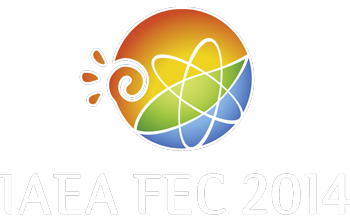Speaker
Dr
Saskia Mordijck
(College of William and Mary)
Description
Turbulent particle transport and momentum transport have been shown to be closely connected theoretically as well as experimentally. In DIII-D H-mode plasmas we study the changes in particle and momentum transport across the linear ITG-TEM stability regime as well as studying the changes in particle transport as a function of the rotation profile. Counter to previous experimental [1], we do not find a correlation between normalized rotational shear (u’) and density peaking [max(a/Ln)] and only a weak dependence of core Te/Ti on density peaking. The density profiles do not become more peaked when we vary u’ from, by changing the momentum injection with the neutral beams. However, there is a correlation between the radius where, the maximum peak in the density scale length occurs and the radius at which the plasma transitions from ITG to TEM. We find that the intermediate density fluctuations increase in the core of the co- and balanced injected experiments and decrease outside mid-radius when compared with the counter-injected experiment. Together with a strong reduction in ExB shear outside mid-radius, this should result in a large increase in transport for the counter injected case. However, experimental perturbative D and v transport coefficients show that the increase in D for the counter-injected experiment is fully countered with an even stronger increase in v. In order to further study the role of turbulence in determining particle and momentum transport, we compare experiments in which we vary the heating from dominantly NBI-heated to ECH while keeping the injected momentum constant. We find that the ECH plasmas have a slightly more peaked density profile, but the overall density is strongly reduced. The rotation profiles for the ECH plasmas are more flat, but no rotation reversal is observed even though the plasmas transition from ITG to TEM close to mid-radius. The NBI heated plasmas all exhibit a rotational “well” in the pedestal area, which is not observed in the ECH heated plasmas and results in an overall lower core rotation. When adding a gas puff in the ECH heated plasma, we observe the return of the rotational well and the overall reduction of the core rotation at higher density.
This work supported by the US DOE under DE-SC0007880, DE-FG02-08ER54984, and DE-FC02-04ER54698.
[1] C. Angioni et al. Nucl. Fusion 51 (2011) 023006
| Country or International Organisation | USA |
|---|---|
| Paper Number | EX/P2-30 |
Author
Dr
Saskia Mordijck
(College of William and Mary)
Co-authors
Dr
C. Craig Petty
(General Atomics)
Dr
Colin Chrystal
(University of California San Diego)
Mr
E. J. Doyle
(University of California-Los Angeles)
Mr
L. Schmitz
(University of California-Los Angeles)
Dr
Won Ha Ko
(Korea, Republic of)

